The health and soft power benefits of art were on the agenda In the Pompadour Room of Paris’s Hotel Le Meurice when the World Economic Forum (WEF) and the J. Paul Getty Trust co-hosted a “cultural table” dinner for art world leaders, exploring the theme “Bridging Worlds: Culture as a Force for Connection in Times of Division”.
The Paris Art Week event was co-hosted on 23 October by Katherine Fleming, the president and chief executive of the J Paul Getty Trust, and Joseph Fowler, the head of arts and culture at WEF. It was held in the mirrored, Louis Seize-style, room where Pablo Picasso celebrated his 1918 marriage to Olga Khokhlova, a principal dancer with Sergei Diaghilev’s Ballets Russes. A portrait over the room’s fireplace still bears the indent from a champagne cork released on that occasion. The historic hotel, in rue de Rivoli, a stone’s throw from Musée du Louvre, was also a home from home to Salvador Dalí, who used it for three decades as his Parisian pied à terre.
The lively Picasso wedding party took place one year after Picasso had made Cubist stage and costume designs for Parade (1917), the first of a number of commissions from the Ballets Russes which concluded with the artist’s The Two Women Running on the Beach (The Race, 1922) being scaled up and used as the front curtain of Le Train Bleu (1924) for its first London performance. The guests at the Meurice wedding party included the artist Max Jacob and two of Picasso’s fellow cultural rainmakers: the polymath Jean Cocteau, who devised the scenario for Parade, and the poet Guillaume Apollinaire, who wrote the programme notes for the same production.
The Hotel Le Meurice, home to the dinner co-hosted by the J. Paul Getty Trust and the World Economic Forum and previously to the 1918 wedding reception of Pablo Picasso and Olga Khokhlova Wikimedia Commons
The event was the latest in a series of WEF cultural tables run by Fowler since 2023, in London, New York and now Paris. Others have been held at Davos, where the world’s business and political élite engage in high-level encounters at the WEF’s annual meetings in the Swiss mountain retreat and where Fowler has developed a substantial and diverse arts and culture programme. The Paris event was the first cultural table to be held in collaboration with the J Paul Getty Trust and the first event of its kind to be co-presented by Getty and the WEF.
The purpose of the WEF cultural tables, Fowler tells The Art Newspaper, is “to place culture at the heart of global change. What began as an idea has grown into a global movement … uniting leaders across art, policy, and enterprise in a format that is intentionally intimate, and radically human. I believe the cultural sector holds immense, still-untapped power to shape the systems-level transformation our world urgently demands. The cultural table exists to activate that power, by bringing together the thinkers, makers, and doers who are redefining how we live, work, and connect. In this space, creativity is not a luxury. Empathy is not a soft skill. Collaboration is not a side note. They are the tools of serious change, and The cultural table is where we put them to work.”
“The data show us,” Fleming said at the cultural table at the Meurice, that experiencing art “literally brings down your blood pressure, it reduces your chances of stroke and heart attack, and it also tends to be much nicer than pretty much anything else you could be doing with [that] half-hour”. In order to understand the world, Fleming said, humans “create simulacra of the world in which we live. That’s why we make films. That’s why we act. That’s why we write novels”. It is “a great mistake” Fleming added, that the idea of art and culture has become politicised, particularly in the US: “It is the one thing that is universally unifying and that is common to all of us.”
It is virtually impossible to convey, she said, “how absolutely fundamental” art and culture is to everything that the J.Paul Getty Trust does and “how delighted we are that the World Economic Forum has a whole section that is devoted to this”. The trust operates the J. Paul Getty Museum in Los Angeles—split between the Getty Center in Brentwood and the Getty Villa in Pacific Palisades—and runs the Getty Foundation, the Getty Research Institute (GRI), and the Getty Conservation Institute. It backs art programmes around the world. Through a partnership between the Getty Foundation and the GRI, it acts as a grant-making presenting sponsor of PST Art, a programme held every five years to bring together art exhibitions held across California.
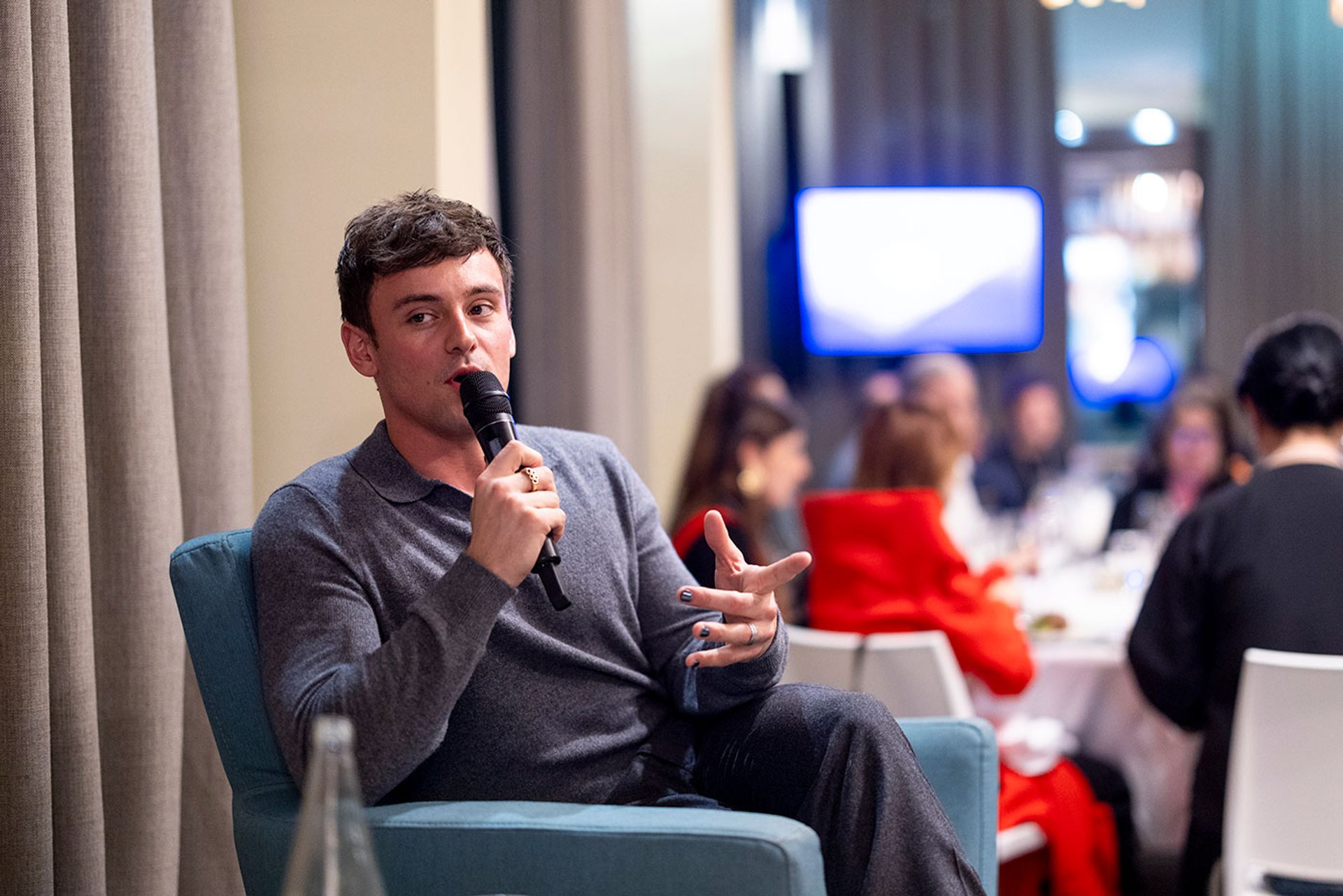
Tom Daley, the Olympic champion diver, LGBTQI+ and knitting advocate, speaking at the cultural table at the World Economic Forum annual meeting, at Davos, January 2025 Courtesy the World Economic Forum
The history of the cultural table
The subject matter of previous WEF cultural tables give a flavour of their proceedings: “Sustainability Through a Cultural Lens”, in New York, 2023 (when the media artist Refik Anadol was among the speakers); “Trust Me, I’m an Artist”, in Davos, 2024 (when the Indigenous leaders from Brazil Chief Nixiwaka Yawanawá and Chief Putanny Yawanawá, the musician Nile Rodgers and the artist Benjamin Von Wong were among the speakers); “Artists to the Rescue” (New York, 2024) with an emphasis on the role of the arts in fostering empathy, connection, and global solidarity; “Art Can Change the World” (Davos, 2025) when Tom Daley, the Olympic champion diver, LGBTQI+ and knitting advocate, Mel B, the Spice Girl and domestic violence campaigner and the dance star Misty Copland were among the speakers; “Designing the Future” (London, 2025), featuring the work of the artist and researcher Sougwen Chung; and “Artists as Architects of Tomorrow” (New York, 2025), where speakers included the marine biologist, photographer, and environmentalist Cristina Mittermeier.
A connection with Diaghilev
Hans Ulrich Obrist, artistic director of Serpentine Galleries, said in his contribution to the Paris event that he was glad to be in a room connected with Digahilev’s memory, because the ballet impresario was formerly a curator of paintings and the “real reason” that Obrist became a curator himself. With the Ballets Russes, Obrist said, Diaghilev created a format where he would bring all the disciplines together: “And that, I think, connects in a wonderful way to today’s topic [of ‘Bridging Worlds’].”
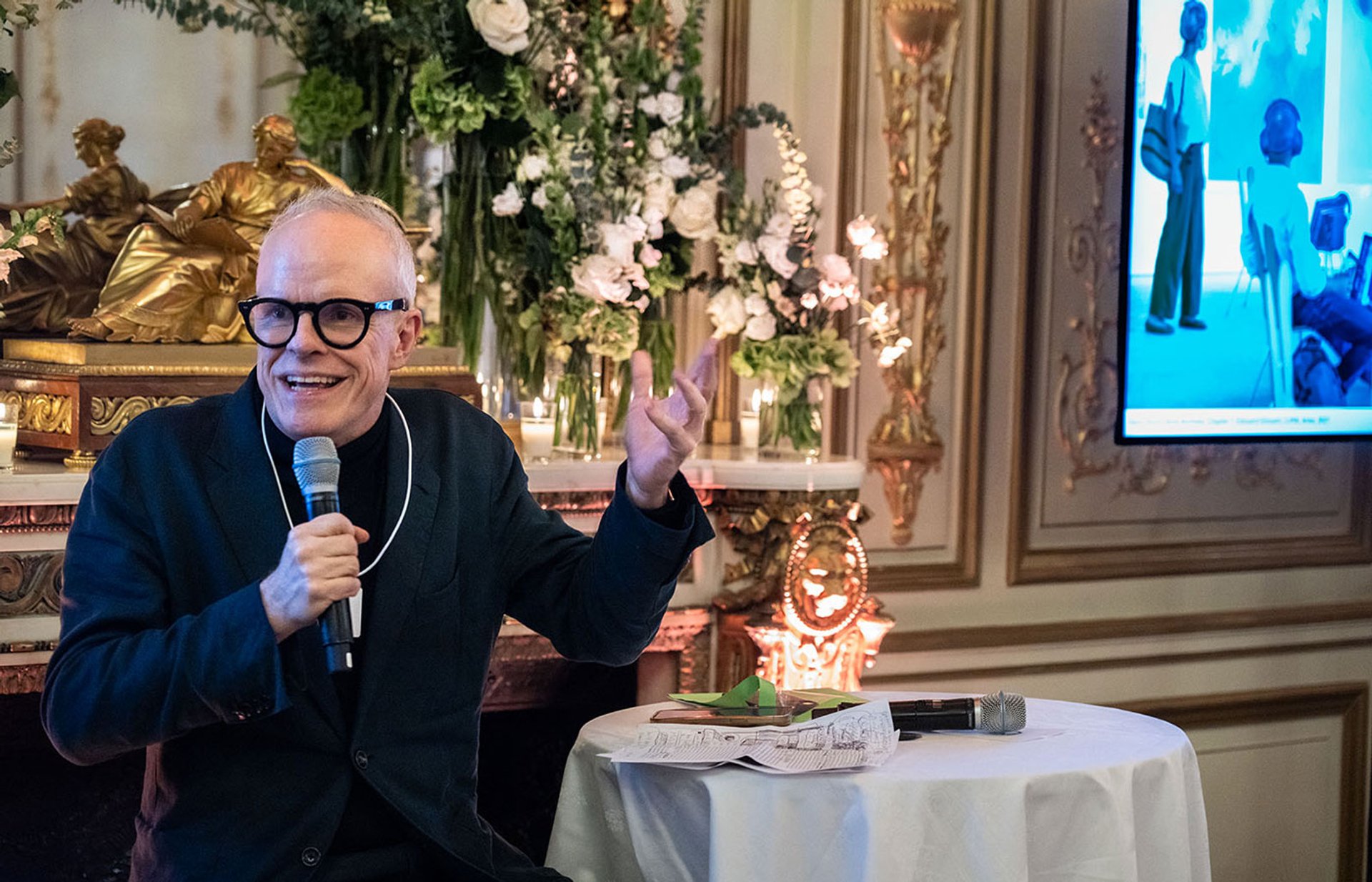
Hans Ulrich Obrist, the artistic director of Serpentine Galleries, London, speaking at the Paris cultural table Courtesy the World Economic Forum and the J Paul Getty Trust
“We need to break down silos of different fields in society which don’t talk to each other,” Obrist said, citing the example of video games, which have been at the centre of a number of ground-breaking exhibitions at Serpentine in the past decade. “Today, more than a third of the world population,” he said, “play video games. So what was a niche activity has become one of the big stories of our time … Bringing people together in new ways, in the context of play is a source of culture. And that’s of course what’s happening today with video games. They let us experience a certain agency which otherwise we might not have.”
“Maybe if you want to go beyond this idea of divisions we need to create spaces where people have different opinions where they can come together because I think we lack these spaces today,” Obrist said. “We lack them online and we lack them physically.” He went on to cite an exhibition that addresses this challenge: Danielle Brathwaite-Shirley’s exhibition THE DELUSION (at Serpentine North until 18 January 2026), a multiplayer immersive experience which runs on game engines and explores themes of polarisation, censorship, and social connection and places the audience at the heart of the experience. “So the project invites participants to come, to discuss and to reconnect,” Obrist said. “It really is a community game.”
The power of cultural empathy
The Paris-based architect turned artist Guillaume Sardin, speaking in conversation with Fleming, addressed his own experience of culture as a force for connection. While spending five years in Kigali, the capital of Rwanda, in the early 2010s, as an architect recently qualified in his native city of Nantes, northwestern France, he was invited to create a new university syllabus for architecture in Kigali. Asked by Fleming what assumptions he made when receiving such an invitation, Sardin said he studied the architecture of post-colonial independence in countries such as Nigeria and Tanzania, as well as the typology of traditional habitats, and the history of place in Rwanda. This approach was designed to take the curriculum away from its Western-centric past, to help Rwandan architecture students to re-appropriate that story.
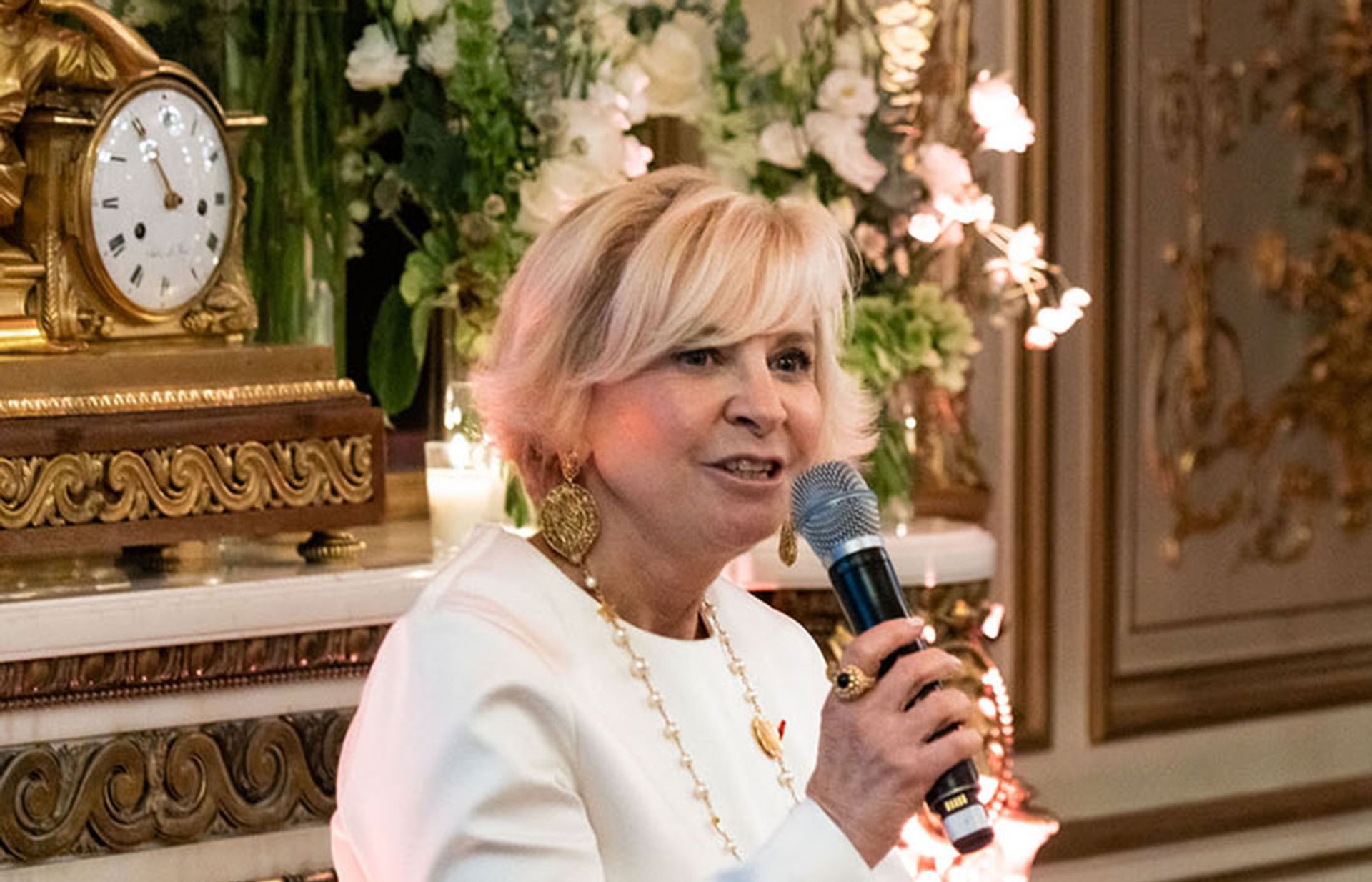
Bénédicte Epinay, president and chief executive of the Comité Colbert, addressing the Paris cultural table Courtesy the World Economic Forum and the J Paul Getty Trust
When, having switched his practice to painting, he was invited back to Rwanda more recently, for a one-month residency by two local art centres, L’ESPACE and Atelier, he was conscious of treading with care in forming a hybridised art: bringing Rwandan history, myth and cultural objects together with his Western-trained practice. “It’s a way to build bridges if you do it with care and with attention to the local community,” he said. His residency piece tells the story of Nyagakecuru, a 16th-century female leader from south Rwanda, in the form of a wooden triptych accompanied by traditional Rwandan Ingogoro milk jugs painted in the manner of a Greek vase. The Ingogoro jugs are a “very very important part of Rwandan culture”, Sardin said, and “because I’m a western artist I wanted to turn them into Greek paintings so they might be like the Greek paintings you can find at the Athens museum”.
The effect of cultural diplomacy
Bénédicte Epinay, president and chief executive of the Comité Colbert—the association representing the great luxury maisons of France—spoke about the soft power of art and culture. And the importance of maintaining artisanal skills. She referred back to Jean-Baptiste Colbert, after whom the Comité was named at its founding in 1954, Louis XIV’s finance minister, and his vision of setting up centres of excellence in France for the making of jewellery, luxury fabrics, watchmaking and more—attracting the best of the best from around the world—with a series of national academies to shore up educational standards as the route to a robust national economy. The historic importance of that supporting of an artisanal skill base was demonstrated, Epinay said, by the recent completion of the “identical reconstruction” of the historic cathedral of Notre Dame in Paris, following the disastrous fire of April 2019. She also cited the diplomatic value of the exhibition Jeux de mains (Hand Games), supported by Comité Colbert and curated by the Chinese artist Jiang Qiong Er in Shanghai in 2024 as a shared celebration of French and Chinese artisanal traditions. The exhibition, and the conversations it generated helped to reverse, by July 2025, a situation where French import taxes on Chinese electric cars had been countered by a corresponding Chinese tax on imports of Cognac from France.
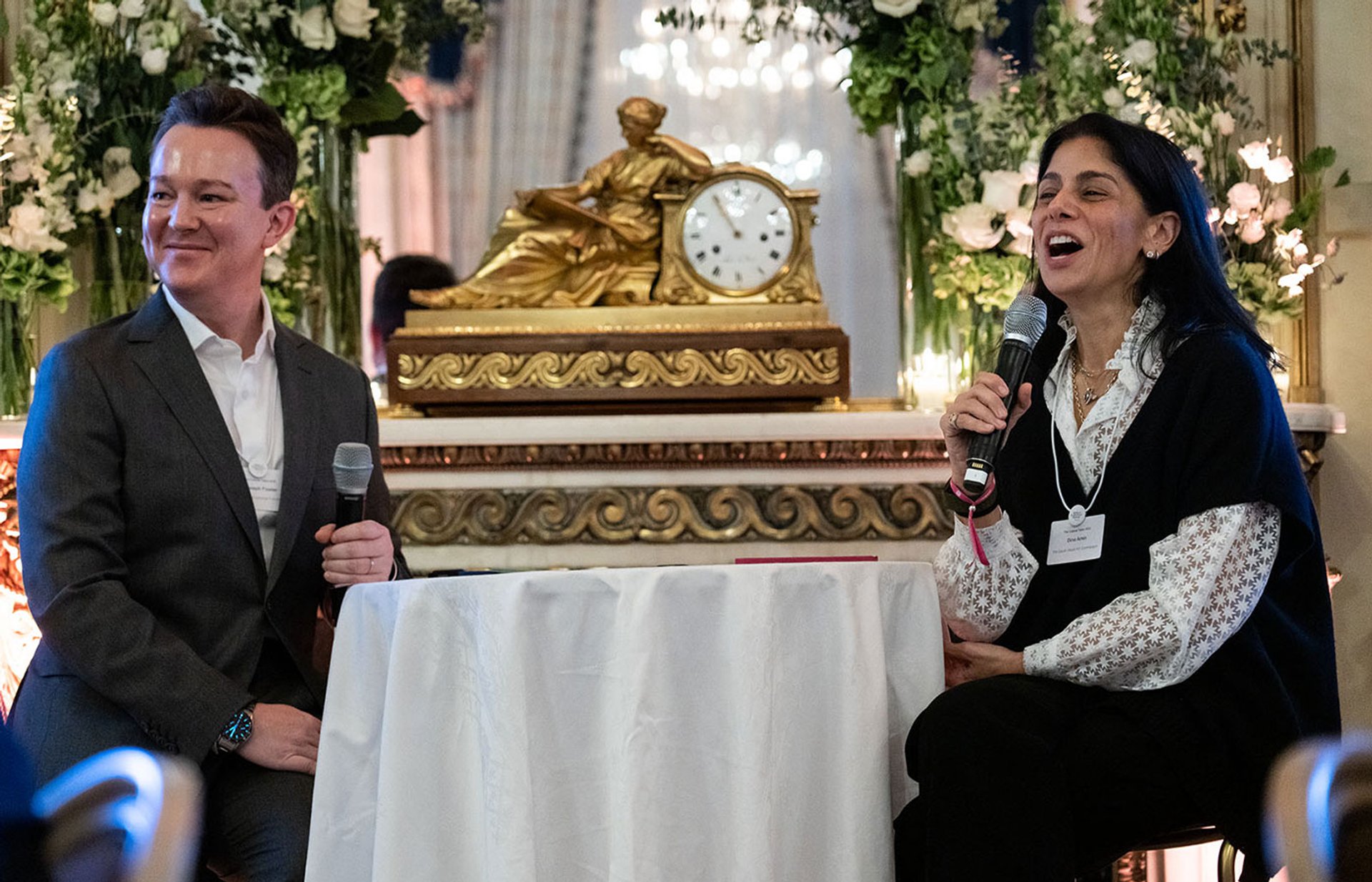
Joseph Fowler, the head of arts and culture at the World Economic Forum, and Dina Amin, CEO of the Visual Arts Commission in Saudi Arabia, at the Paris event Courtesy the World Economic Forum and the J Paul Getty Trust
The value of cultural education
In conversation with Fowler, Dina Amin, CEO of the Visual Arts Commission (VAC) in Saudi Arabia, who is responsible for the strategic vision for developing of the Saudi visual arts sector, spoke of her lifelong concern, built up during periods working in the London and New York art scenes, for building bridges with unheard voices in the art world. She cited the particular importance to her of Without Boundary: Seventeen Ways of Looking (2006), at MoMA, in New York, an exhibition featuring the work of artists including Mona Hatoum, Shirin Neshat, and Shahzia Sikander. For Amin, seeing that exhibition “was the first time I was really confronted with the idea of art from the Middle East being absent in my life, despite the fact that I’ve seen hundreds of objects on a daily basis”. It brought home to her that the modern and contemporary art of the Middle East “was not captured formally in education” during her upbringing in that region. So when she was approached to lead VAC, she saw a great chance to build educational platforms in a country where 70% of the population is under the age of 35.
When Saudi Arabia rolled out Vision 2030 for the future of the country, Amin said, “there was a huge emphasis on art and culture and the youth that are going to be driving the country forward, the youth who are moving from today to tomorrow and beyond”. VAC is one of 11 commissions, launched in 2020, under a ministry of culture that was itself founded in 2018. “The Visual Arts Commission’s job and my job,” she said, “is to make sure that we are giving platform to artists and artists do what artists want to do within their practice, as do curators, as do all the other cultural practitioners and our job is to make sure that we are allowing those voices to ring loud and true and clear.”
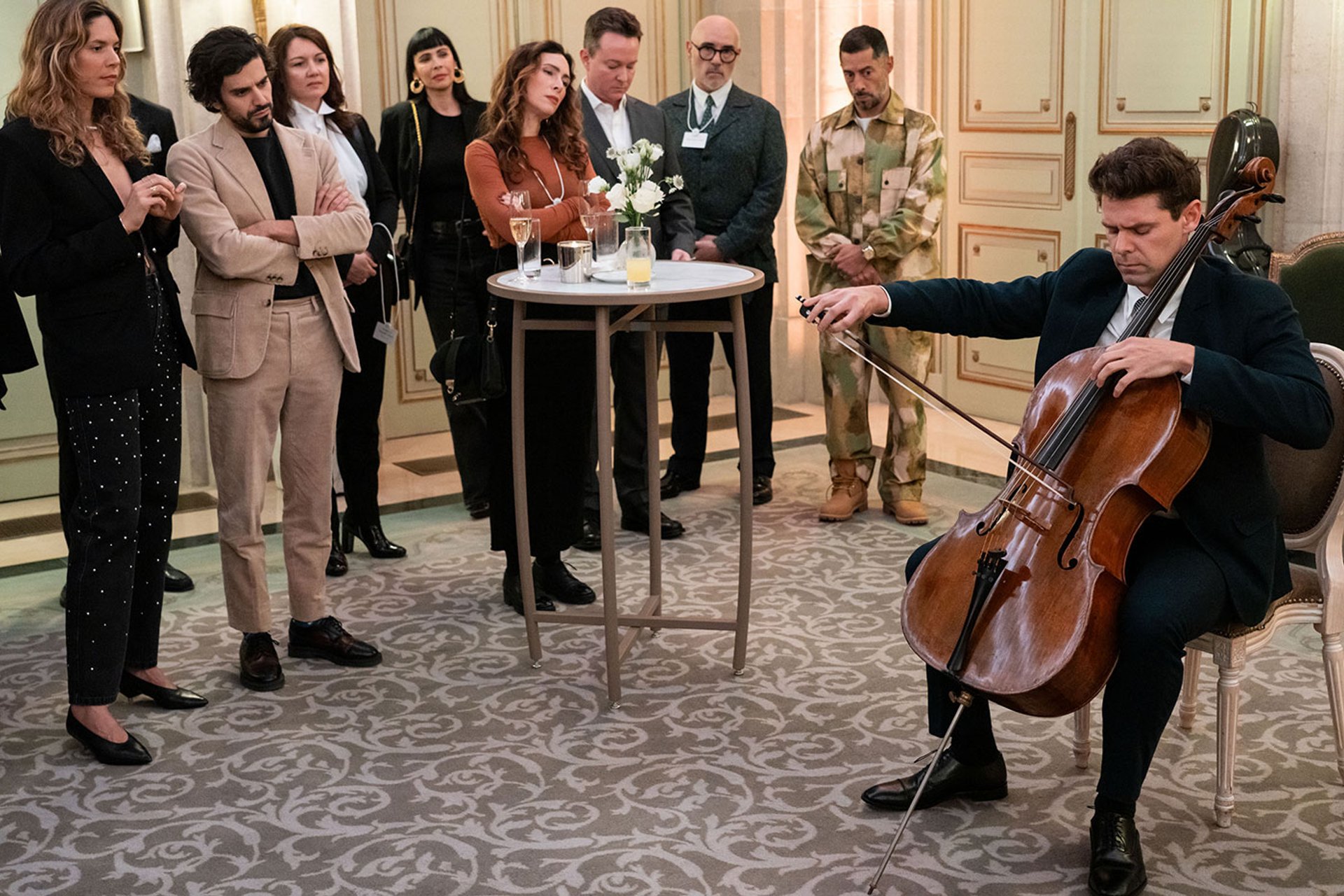
The cellist Christian-Pierre La Marca plays at the Paris cultural table Courtesy the World Economic Forum and the J Paul Getty Trust
Artists at the core and at the edge
Mirek Dusek, WEF’s chief business officer and managing director, said at the Paris event how important it has been at a time of division for the organisation to build on its engagement with leaders from the worlds of art and culture, a sector that is “one of the mechanisms for us to really connect as humans… being united in our humanity and shared experiences”. Dusek also referred to the present age of “exponential innovation”, and the question that it begs of artists and cultural thinkers: a “nice tension between being at the core, but also being at the edge, looking over the horizon, particularly for example, if we take AI and the rapid advancements with that technology and what it means to be human. How can it help humans? Are we really clear-eyed about how to make sure it helps humans?”
“Art and culture have always been at the center and everything else has in fact been on the periphery,” Fleming said, adding that the occasion could not go by without a mention of Plato, quoting the Greek philosopher’s dictum “art and culture sink deep into your soul and take hold of you”.
